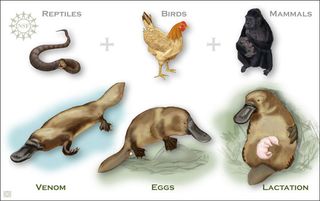
BOX FROM PLATYPUS EVOLUTION FULL
"The presence of the full repertoire of milk genes confirms that lactation evolved at least 166 million years ago, way before live-bearing," Graves said. While milk production and giving birth to live young would seem to go hand in hand, the platypus genome shows that the two common mammalian traits evolved at very different points in evolutionary time. On the other hand, the set of mammalian genes responsible for lactation-or milk production-was also found in the platypus genome. "The new genomic data make a water-tight case for egg-laying truly being a primitive retention from reptilian ancestors," said Matt Phillips, an Australian National University scientist who was not involved in the genome project. For example, the researchers identified genes for egg yolk proteins shared only with reptiles and fish. )Īs part of the new study, researchers compared the platypus's genetic makeup with other fully sequenced genomes, including those of chickens, mice, and humans.Ī central goal was to determine which platypus features may have been inherited from ancient reptilian ancestors and which evolved independently in the monotreme lineage.Īs expected, platypus DNA was found to include a number of genes not found in other mammals. (Read related story: "Platypus Much Older Than Thought, Lived with Dinos". Eggs and MilkĪquatic animals native to eastern Australia, platypuses have long perplexed biologists.Īlthough classified as mammals, they retain a number of primitive characteristics-including egg-laying-that are thought to have been passed down from mammal-like reptiles that lived over 300 million years ago.įebruary 6, 2009-National Geographic researchers are trying to collect DNA samples from these odd duck-billed mammals to determine whether there are separate subspecies. "The platypus is critical to helping us understand what genes were present in the ancestral reptilian lineage and how mammals evolved their particular traits," Warren said. That early divergence means platypus genes carry information from a transitional point on the evolutionary time line leading from reptiles to mammals, said project leader Wesley Warren of Washington University in St. The group of animals called monotremes-which includes the platypus and the closely related echidna-is thought to have split from other mammals at least 166 million years ago. The analysis confirms that the platypus was the earliest offshoot of the mammalian family tree, Graves noted. "The platypus genome, like the animal itself, is an amazing amalgam of reptile-like and mammal-like features," said project co-leader Jennifer Graves, of the Australian National University in Canberra. The study, appearing in today's edition of the journal Nature, gives scientists a new window into the genetic architecture of the earliest mammals.


The duck-billed mammal has a genetic affinity with both reptiles and birds, according to a new study.ĭecoding the platypus genome has long been an important goal for biologists seeking to understand the origins of mammal evolution. The genome of the platypus-our most distant mammal relative-has been decoded and analyzed, researchers reported today.


 0 kommentar(er)
0 kommentar(er)
